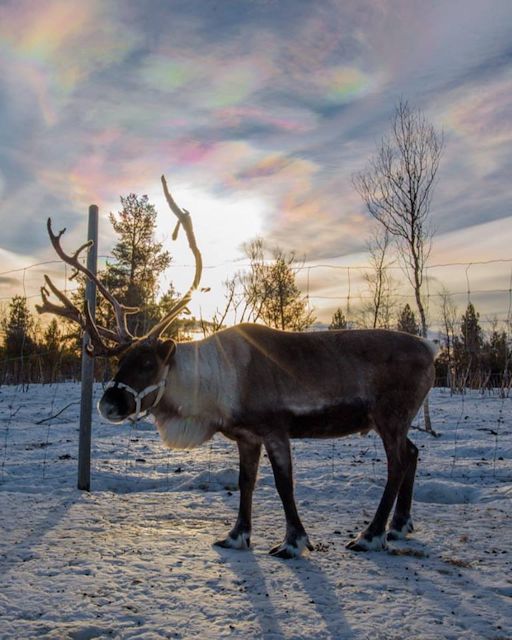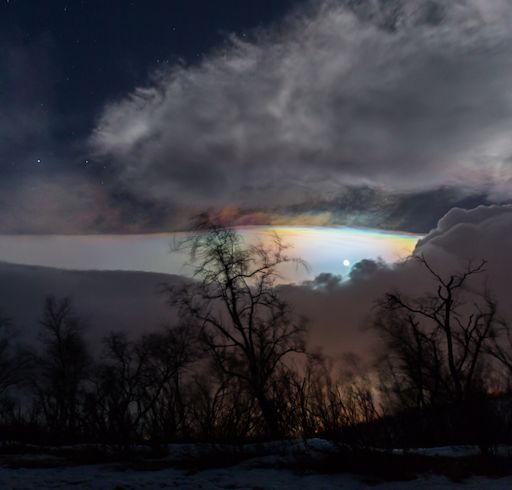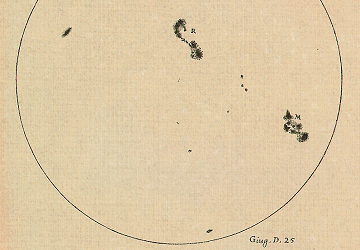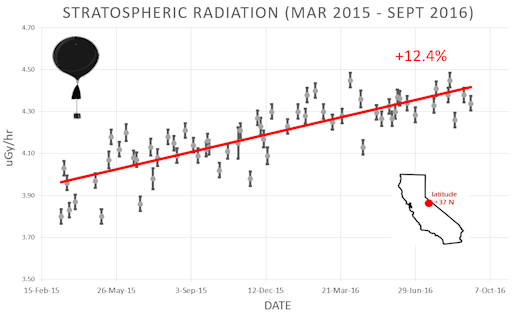Directly under the Arctic Circle! Marianne's Arctic Xpress in Tromsø offers fjord, whale and wildlife tours by day, aurora tours by night. Book Now for out of this world day and night adventures. | | |
SOLAR WIND, INCOMING: A stream of solar wind is heading for Earth, due to arrive later today (Feb. 15th) or tomorrow (Feb. 16th). The stream is flowing from a canyon-shaped hole in the sun's atmosphere. NOAA forecasters say there is a 40% chance of polar geomagnetic storms when the solar wind arrives. Free: Aurora alerts.
DAYTIME AURORAS? NO. POLAR STRATOSPHERIC CLOUDS: On Feb. 13th, something amazing happened in the stratosphere over the Arctic Circle. Normally, the air 60,000+ feet above Earth's surface is dry and utterly transparent. On the eve of Valentine's Day, however, the Arctic stratosphere filled with a gossamer haze of crystalline ice, and when sunlight hit the freezing crystals, the sky filled with clouds of intense iridescent color.
"Our guests referred to the clouds as 'daytime auroras,'" reports Chad Blakley, who operates the Lights over Lapland tour guide service in Abisko, Sweden. One of them, Champ Cameron (@champcameron on Instagram), snapped this picture of the display:

"Champ was participating in our Sami And Reindeer Experience outside of Abisko yesterday afternoon," explains Blakley. "The roads were very icy due to a freak rain storm and warm weather (+9 degrees C) so we nearly canceled the trip. But we heard that there were incredible clouds in the sky so we chose to brave the weather and push on."
Good thing. They witnessed an exceptional display of polar stratospheric clouds (PSCs). PSCs are a sign of very cold temperatures in the stratosphere. For ice crystals to form in the normally arid stratosphere, temperatures must drop to around -85º C. So while it was
strangely warm on the ground below, it was incredibly cold up above.
Longtime observers say PSCs are becoming more common and more intense. "I've been living here all my life (33 years)," says Mia Stålnacke of Kiruna, Sweden, who also photographed
the colorful outbreak. "I definitely feel that these clouds are appearing more often then they used to. I remember seeing them a few times/year since I was a kid, but these last couple of years we've had them much more often--sometimes for almost a week straight. Others seem to feel the same way; I see local groups on Facebook flooded with photos of PSCs and comments on how often they're appearing now."
"Our bus driver, a longtime resident of the area, described it as the best PSC display he had ever seen," relays Blakley. "We were overwhelmed by the natural beauty." The clouds were so intense, they remained visible even after the sun set:

"We saw these clouds all day long, and they continued into the night," says photographer Lars Lehnert of Abisko, Sweden. " I've never seen anything quite like it."
Once thought to be mere curiosities, some PSCs are now known to be associated with the destruction of ozone. Indeed, an ozone hole formed over the UK in Feb. 2016 following an outbreak of ozone-destroying Type 1 PSCs.
To investigate these clouds further, Spaceweather.com and the students of Earth to Sky Calculus will travel to Abisko Sweden for a week in March 2017. We plan to launch a series of space weather balloons into the Arctic stratosphere, measuring temperature, air pressure, and ambient radiation. If PSCs are present, our sensors will pass directly through them, and our cameras can photograph the colorful clouds at point blank range. Stay tuned!
Realtime PSC Photo Gallery
HAPPY BIRTHDAY, GALILEO: On February 15, 1564, Galileo Galilei was born in Pisa, Italy. Galileo is an important person in the history of space weather. Contrary to popular belief, he didn't discover sunspots, but he was one of the first to observe them using a telescope.
In Galileo's day, many people believed sunspots were satellites of the sun. Galileo proved otherwise. By drawing sunspots every day, he discovered that the sun spins and that sunspots are located on (or very near) the sun's surface. Galileo thought sunspots might be clouds.

Sunspots sketched by Galileo on June 25, 1613: more.
Now we know what sunspots really are: huge islands of magnetism. Magnetic fields generated by the sun's inner dynamo poke through the sun's surface, forming dark areas typically a few times wider than Earth. The behemoths Galileo sketched in 1613 were as wide as Jupiter.
If Galileo were alive today, the 453-year-old scientist would make less progress on the problem of sunspots. The solar cycle is currently crashing towards a deep minimum expected in 2019-2020; the sun's dark cores are shrinking and becoming less frequent. To the sunspots, we wish many happy returns.
Realtime Space Weather Photo Gallery
Realtime Aurora Photo Gallery
Every night, a network of
NASA all-sky cameras scans the skies above the United States for meteoritic fireballs. Automated software maintained by NASA's Meteoroid Environment Office calculates their orbits, velocity, penetration depth in Earth's atmosphere and many other characteristics. Daily results are presented here on Spaceweather.com.
On Feb. 15, 2017, the network reported 15 fireballs.
(15 sporadics)

In this diagram of the inner solar system, all of the fireball orbits intersect at a single point--Earth. The orbits are color-coded by velocity, from slow (red) to fast (blue). [Larger image] [movies]
Potentially Hazardous Asteroids (
PHAs) are space rocks larger than approximately 100m that can come closer to Earth than 0.05 AU. None of the known PHAs is on a collision course with our planet, although astronomers are finding
new ones all the time.
On February 15, 2017 there were potentially hazardous asteroids.
Notes: LD means "Lunar Distance." 1 LD = 384,401 km, the distance between Earth and the Moon. 1 LD also equals 0.00256 AU. MAG is the visual magnitude of the asteroid on the date of closest approach. | | Cosmic Rays in the Atmosphere |
Readers, thank you for your patience while we continue to develop this new section of Spaceweather.com. We've been working to streamline our data reduction, allowing us to post results from balloon flights much more rapidly, and we have developed a new data product, shown here:

This plot displays radiation measurements not only in the stratosphere, but also at aviation altitudes. Dose rates are expessed as multiples of sea level. For instance, we see that boarding a plane that flies at 25,000 feet exposes passengers to dose rates ~10x higher than sea level. At 40,000 feet, the multiplier is closer to 50x. These measurements are made by our usual cosmic ray payload as it passes through aviation altitudes en route to the stratosphere over California.
What is this all about? Approximately once a week, Spaceweather.com and the students of Earth to Sky Calculus fly space weather balloons to the stratosphere over California. These balloons are equipped with radiation sensors that detect cosmic rays, a surprisingly "down to Earth" form of space weather. Cosmic rays can seed clouds, trigger lightning, and penetrate commercial airplanes. Furthermore, there are studies ( #1, #2, #3, #4) linking cosmic rays with cardiac arrhythmias and sudden cardiac death in the general population. Our latest measurements show that cosmic rays are intensifying, with an increase of more than 12% since 2015:

Why are cosmic rays intensifying? The main reason is the sun. Solar storm clouds such as coronal mass ejections (CMEs) sweep aside cosmic rays when they pass by Earth. During Solar Maximum, CMEs are abundant and cosmic rays are held at bay. Now, however, the solar cycle is swinging toward Solar Minimum, allowing cosmic rays to return. Another reason could be the weakening of Earth's magnetic field, which helps protect us from deep-space radiation.
The radiation sensors onboard our helium balloons detect X-rays and gamma-rays in the energy range 10 keV to 20 MeV. These energies span the range of medical X-ray machines and airport security scanners.
The data points in the graph above correspond to the peak of the Reneger-Pfotzer maximum, which lies about 67,000 feet above central California. When cosmic rays crash into Earth's atmosphere, they produce a spray of secondary particles that is most intense at the entrance to the stratosphere. Physicists Eric Reneger and Georg Pfotzer discovered the maximum using balloons in the 1930s and it is what we are measuring today.
| | The official U.S. government space weather bureau |
| | The first place to look for information about sundogs, pillars, rainbows and related phenomena. |
| | Researchers call it a "Hubble for the sun." SDO is the most advanced solar observatory ever. |
| | 3D views of the sun from NASA's Solar and Terrestrial Relations Observatory |
| | Realtime and archival images of the Sun from SOHO. |
| | from the NOAA Space Environment Center |
| | a proud supporter of science education and Spaceweather.com |
| | fun to read, but should be taken with a grain of salt! Forecasts looking ahead more than a few days are often wrong. |
| | from the NOAA Space Environment Center |
| | the underlying science of space weather |
 | Beautyz for top beauty products reviews and their buying guides |
| | These links help Spaceweather.com stay online. Thank you to our supporters! |

